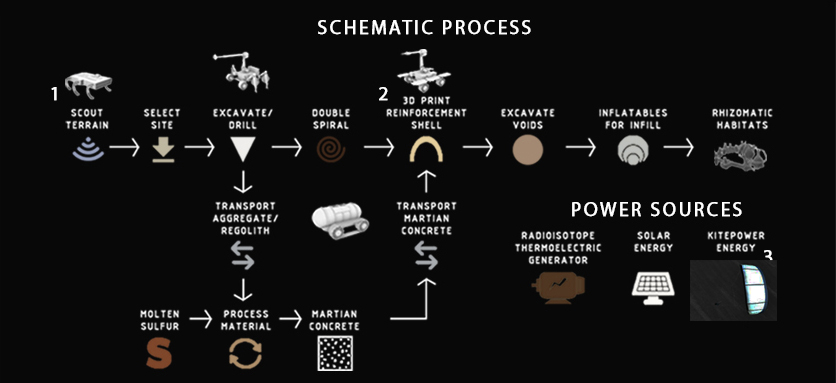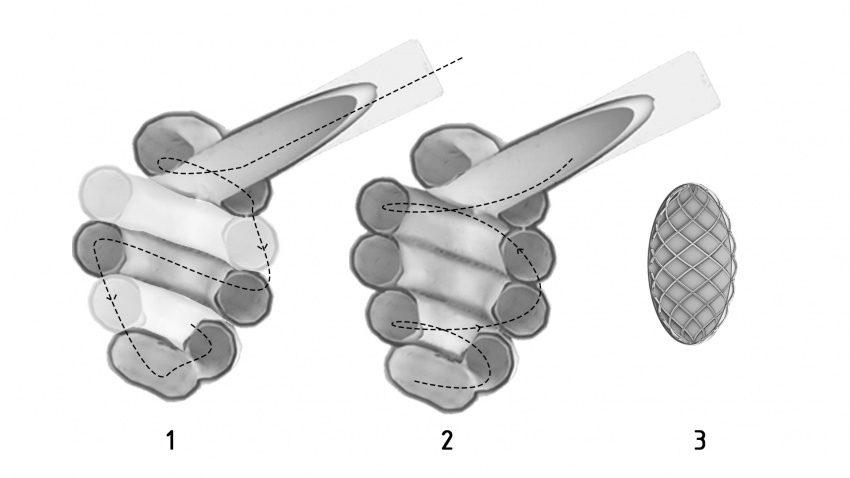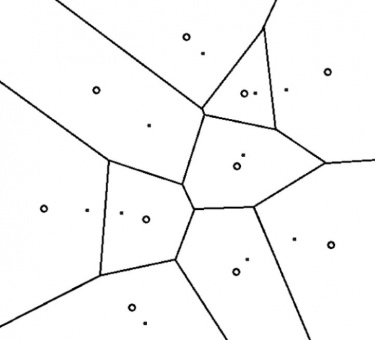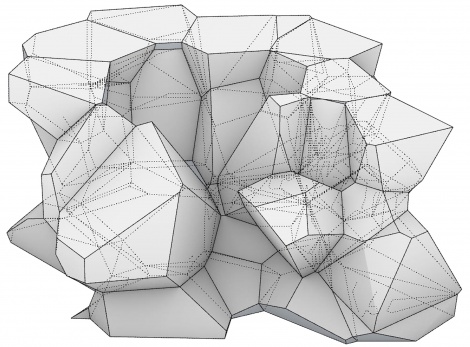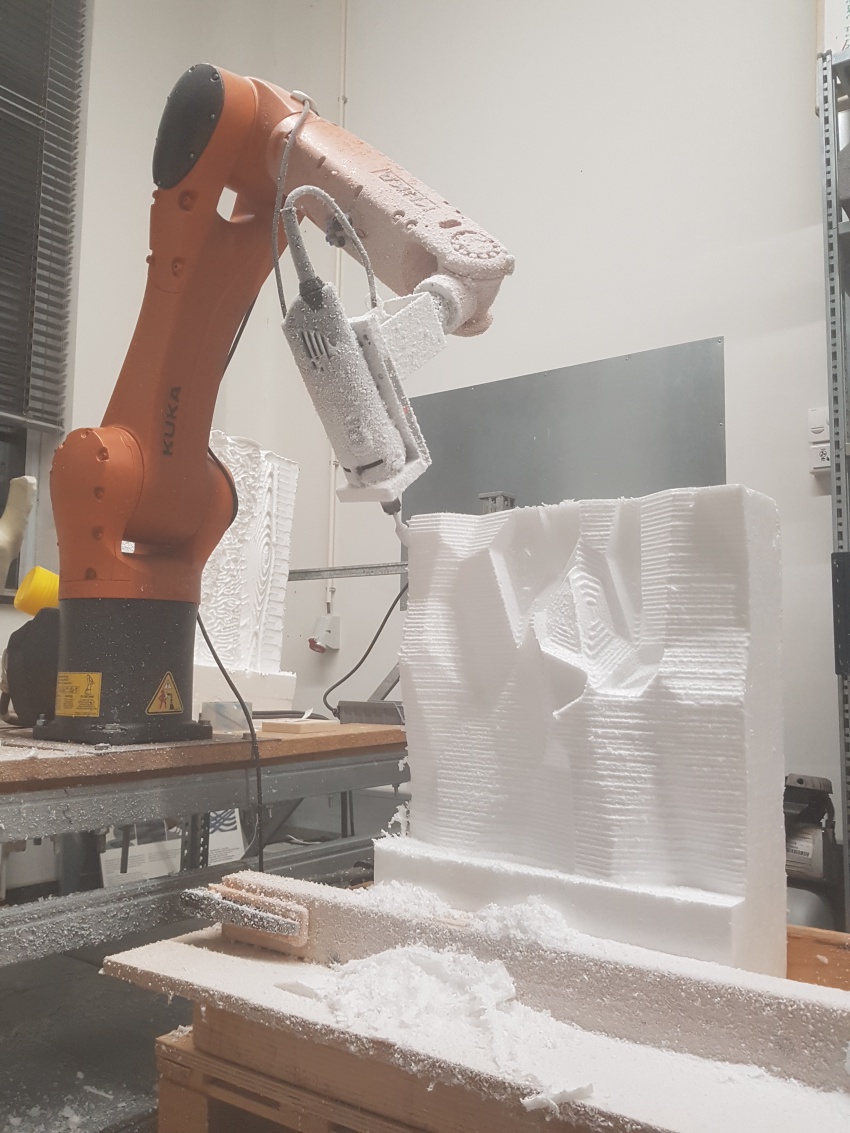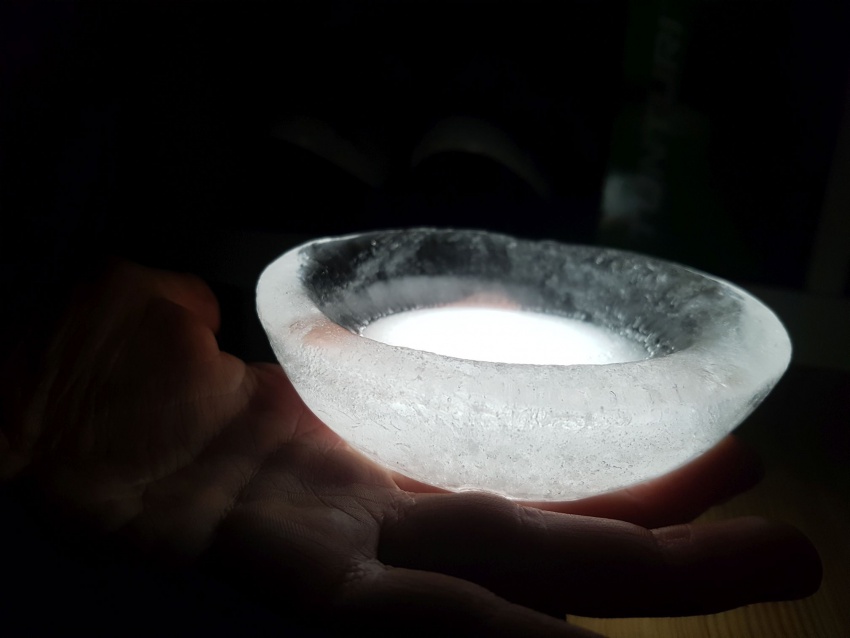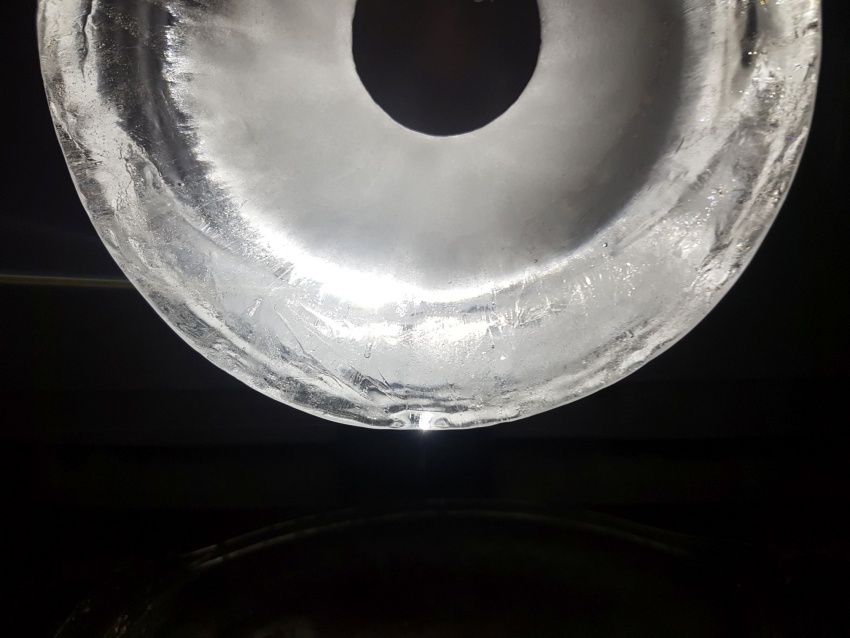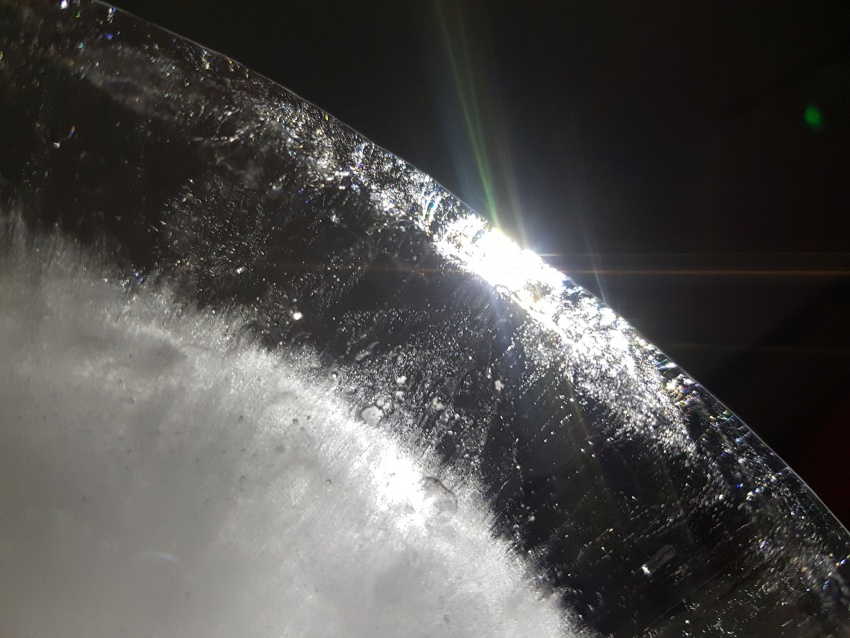Difference between revisions of "Shared:2019Concept"
(Created page with "__NOTOC__ __NOTITLE__ =='''Off-Earth Manufacturing and Construction (of Habitats)'''== <div style="height:30px; width: 850px; margin:0px; padding: 0px; padding-top: 20px; bo...") |
(No difference)
|
Revision as of 11:58, 16 January 2024
Off-Earth Manufacturing and Construction (of Habitats)
Process
Excavation and inflatable structure
1. First phase of robot-aided, downward progressing excavation and gradual tunnel reinforcement using 3D printing.
2. Completion of excavation in upward movement.
3. Pressurized inflatable (as for instance https://www.extremetech.com/extreme/297081-aerospace-firm-shows-off-giant-inflatable-space-habitat) for the living environment is placed in the created cavity between the spiraling tunnels.
Reference: Inflatable Structure for Space- PDF Link
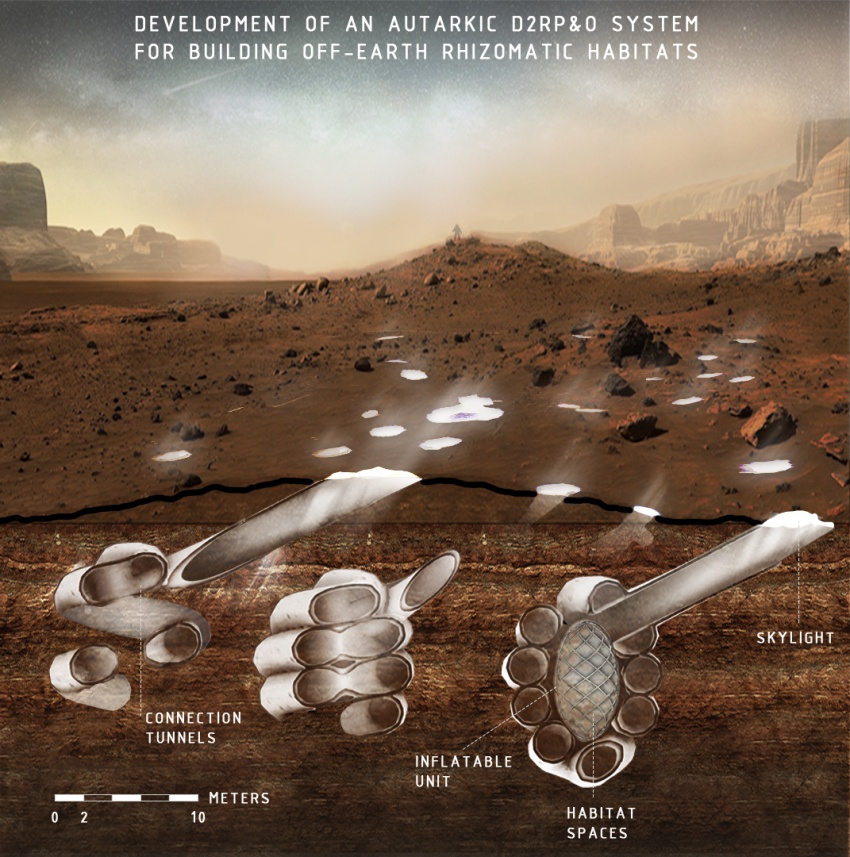 Fig.1: In-situ progress of excavation and preparation of inhabitable spaces
Fig.1: In-situ progress of excavation and preparation of inhabitable spaces
Melissa Life Support System - a conversation with Robert Lindner and Christel Paille from ESA
The Melissa system is a unique and indispensable tool for space exploration. It ensures a reliable support of vital functions during the flight with potential use for Off-Earth Habitats. We have talked with Robert Lindner and Christel Paille from ESA ESTEC about the integration of this system in our Mars habitat, about the LSS itself and their vision for the future. Following here is a series of topics discussed:
Q: Is it possible to operate Melissa on an economy-system, for instance shut it off for one of the three inflatables it is connected to?
A: The Life Support System is designed to operate at its maximum capacity corresponding to the volume of the habitat it has been designed for. Although this system can be adaptable to different inputs (for instance the metabolism of humans changes during the night), it is preferred not to have accumulations (high inputs and low outputs).
Q: What are the possibilities of scaling up the system? And the challenges?
A: The current capacity of the Melissa prototype for experiments corresponds to the oxygen consumed by one human. We are currently looking into the possibilities of scaling up the system. Because it is based on biochemical processes, the scaling would not be happening in a linear manner (increase in one compartment might cause a three-fold increase in another). Also, regarding the astronauts needs in terms of food, the diet is based on animal input, which currently is more feasible to be provided from Earth.
Q: How much of a Melissa system could be created with materials on site? What is the possibility of the use of regolith/water from the Martian surface?
A: Currently Melissa has a membrane for processing the recycling of grey water. If we think about oxygen, this could be obtained through either electrolysis or classical chemical reduction processes. The regolith on Mars has substantial amounts of oxygen, and if the regolith would be processed for obtaining oxygen, a side effect of this process is obtaining metals as well through the extraction. The challenge is that this process would necessitate complex industrial facilities and considerable amounts of energy. Furthermore, one important implication of supplying resources such as on-site extracted water from ice is the insuring and monitoring of water quality, which does currently take place by ISS within a closed habitat.
Q What is the current capacity of Melissa LSS (in terms of oxygen/water/waste) and how close/far does this system need to be located to the living environment that it serves?
A: Currently the pilot installation in Barcelona is able to recycle 100% of oxygen, water, bio-waste. Provided there is a reliable distribution infrastructure, there is no reason why it should be too close to the system. One idea would be to have a central hub that distributes resources to all the habitats.
Q: What is the degree of redundancy of such a system (imagine loss of insulation capacities of the inflatable/accident)?
A: Operating with a no redundancy or even single redundancy is not an option for the Melissa system. It operates on a redundancy level by which at every moment two systems are working in parallel. In case one of them stops working, the other takes over. Regarding the possibility of an accident such as a fire inside the inflatable, the space must be evacuated and isolated, first extinguishing the fire, switching off the ventilation system, making sure smoke does not spread around and that no more oxygen is coming in.
We are excited to stay in touch with the development of the Melissa system, realizing that the dialogue between the technical development of such a system and its architectural purpose, namely human life support for off-Earth habitats, will be essential.
https://www.esa.int/Enabling_Support/Space_Engineering_Technology/Melissa/Closed_Loop_Compartments
Experiments in Martian farming and ecology - a conversation with professor Wieger Wamelink from WUR
Once the astronauts have a safe environment that provides the oxygen and water needs, the next step is producing fresh food on site. This will primarily mean covering up the caloric and nutritional needs of the new inhabitants, but also the psychological advantages associated with taking care of a garden in space. Professor Wieger Wamelink, ecologist and exobiologist at the University of Wageningen has answered some of our questions regarding the experiments he is performing with the use of Mars soil simulant, as well as various insights into the science behind making (plants) life possible. Here follows a series of questions and answers of our interview:
Q: Professor Wamelink, Do you expect that man's caloric needs on Mars will change much (considering he will have to stay fit, use a lot of sugars = mental energy, other factors)?
A: On Mars gravity is lower. It will cost you less energy to do the same amount of work, but if you go out you will have to carry a suit. You have to be more physically active when you are there. In the end it is difficult to say. For now I reckon it will be a bit more.
Q: What are the plants that have been proven possible to be grown in Mars soil? Which others are potential?
A: What is sure is what we did, and it’s already a wide variety. Let’s start with the sting nettle, that was the first experiment. You can eat it. Not really my target species. A lupin works. From later experiments we have tomato, carrots, radish, rye, potatoes, spinach, rocket (ruccola), garden grass, peanuts, beans and peas. A huge variety of crops. Salad, cucumber and courgette could work. The soil we use now for research is third generation of Mars soil simulant, and that’s very salty. Last year had a group of students working with it, but nothing wanted to germinate in it, nothing was growing and last week I restarted their experiments but I did used a salt plant you can eat glasswort. It is used in salads, and is grown in salt marshes. I’ve sown it last week, this week I’ve got plants in every pot, so they grow, they germinated. It’s just a matter of salt-resistant plants.
This new sample of Mars soil, I have some doubts about it. I am not sure that these salty soils will be present on Mars on all sites. They might be found on lowlands, on former sea areas that have dried up. Higher up on volcanoes, the parts never reached by the sea, the soils will be different.
Q: What is the infrastructure necessary to set up an agricultural system on Mars (per person)? How much energy do you expect this will consume? What does it mean to scale up this system?
A: In the beginning you will have all your resources with you, so everything you can grow in there is an addition to your meal. In the end they have to be self-supporting. You won’t need that much space because you do it three dimensionally, by stacking layers on top of each other. A group of Chinese researchers did calculations an estimated the size of a room of 4x4x4 meters - for the food needs of four persons. I think that is too optimistic, but it gives you some idea about the size. I think will be bigger, but not by much, maybe twice the size. If you look up at the footprint of a person, it will be about the same on Mars. If you look it up for a vegetarian, you have a rough idea – it’s somewhere between 100-200 square meters.
Q: On the ISS agriculture happens in a little box, where all the factors are controlled, and it is more for experimental purposes. How do you imagine agriculture on Mars? Will astronauts use big greenhouse or a cluster of separate boxes?
A: I think it will be a greenhouse and I think it will resemble city agriculture with separate departments to prevent contamination. If something goes wrong in one of the departments, you still have the other department – safety and food safety. I think it will look like that, not like on the ISS – there they don’t use soil or water – because the water would just float around. On Mars of course there is gravity which helps a lot, because you can use normal water and soil. As I see it you will have three systems working in parallel. Some crops will be growing in the soil, some hydroponics, some in aquaponics. The aquaponic you can use to purify the water – and have some fish if you want. Melissa is a lot about hydroculture and aquaponics and I am the only person who is working on soil.
Q: Why do you think that not everything could be grown without soil? Or is it about the advantage?
A: Potato is very difficult, doable but difficult. Some crops will grow better in soil. For tomatoes you can easily use hydroponics. But you still have the urine and feces and if these are not recycled, that corresponds to loss of nutrients necessary to grow plants.
Q: How much in terms of nutrients do you expect it will be necessary to be added to Mars soil to make it productive?
A: Well, I hope you won’t need fertilizer. The first missions will bring their own food, and you eat it, and after that it’s already fertilizer. You will be traveling for at least half a year, maybe 9 months, store your feces, bring them to Mars and then you will have a lot of manure to start with. You can bring bacteria that can make nitrates and ammonium (N2) from the air. Agrobacterium lives in the roots of peas and beans and we already tried that. They can use N2 to turn it into NH4 and later NO3. That’s extremely important because everything that plants need from the Mars soil, every nutrient is there. The only thing that they lack is reactive nitrogen (NO3 and NH4) and that is essential for plant growth. You can take it from manure, but these bacteria, they can take it from the air.
Q: Regarding the CO2, people will need a habitat that is pressurized…
A: Plants as well, plants become very inefficient If the pressure drops. They can grow in lower pressures but efficiency goes down very much – you can lower it as much as 10% of Earth pressure, but then all growth is gone. They still survive, but I assume you will have normal pressurized greenhouse because you have to work in it as well (harvest, look after the plants). By adding a little bit extra CO2, plants will go faster.
Q: What are the way in which is could fail?
A: Well, there are many ways.
Q: But what are the challenges that you still find difficult to cover up for, outside of the research you have already done?
A: Theoretically we know how it all works, but there are many unknowns, even here on earth. I need bacteria but also fungi that can break down organic matter. There are also fungi that live in symbiosis with the roots of the plant and they can get phosphate from bare rocks and share it with the crops. We know it works, and that every species has its own fungi to live with, but it is not so known which species lives with which fungi. The same is for the bacteria. There are many unknowns. We know we can grow plants in sterile conditions, by adding enough nutrients and controlling the process. But the problem is different since we are talking about sustainable ecosystems that we have to build there. We don’t know yet if we can build something like that.
Q: Have you planted in the same soil over and over again, to asses its productivity?
A: Yes, we did. We started with pure bare soil. In the first experiment we didn’t add normal water, but demineralized water, tap water still has some nutrients in it, just to see. Afterwards we started building up the soil. On Mars you will reuse the soil as well. You bring it inside and then you improve it, like we did it on earth for more than 10,000 years. The first harvest will be the poorest one normally. The further you get, the richer the soil, the bigger the harvest will be. In the first 5 years you build it up.
One other big problem is that on Mars there are no fungi, no bacteria, no diseases. So we want to keep it that way. You have to be very careful what soil you bring, otherwise you will not only bring the good bacteria but will also bring the diseases.
Q: How do you build redundancy for such a system? In the case of an accident, in the case of loss of pressurization, have you thought about building redundancy to the system?
A: That task is for the engineers. But I do know what will happen with the plants of course, if you lose pressurization. They will die, immediately, they will freeze, but if you have seeds, they will survive. We freeze them on Earth as well, the seed bank in Spitsbergen. The potatoes will not survive, if you try and bring them back indoors, they are gone.
Q: No more fries for the next 6 months?
A: Of course potatoes also have seeds. Even if it would be easier to bring the seeds to Mars instead of the potato itself, the disadvantage is that it takes a long time from seeds till harvest. It could take over a year.
Q: We have discussed shortly about growing plants under the sun, under an ice dome of thickness 1m (for radiation protection). What are the chances? What kind of artificial light will still need to be supplied for plants?
A: Water and ice don’t transmit light the same way. You are blocking the radiation but you are also blocking UV light, and the plants need it. At maximum it could be 60% on the outside of your ice dome. Maximum 60% of what we receive on Earth. It is enough to grow plants, but you have 40%, maybe 60% less and the growth would be halved. I would always add artificial light, and with that you can provide all the radiation you need. I don’t know what ice does, but I know that red and infrared can go through water, a layer of 1m is no problem, because plants do grow under water. With ice it will be difficult. But if you have artificial lights, it will compensate.
Q: Do you think it will be worth the effort to build a structure such as an ice dome if the plants can get just a bit of sunlight?
A: I would, if it is possible. Going to Mars will all be about energy. All costs energy, the more efficient you are, the better. Of course you can use solar panels but there is still loss of energy then. If you can use direct sunlight it would be better. There is more than one reason, I am now mostly indoors and I don’t prefer this. On Mars, even if you are outside, you would be suited up so if you have a dome of ice where sunlight comes in, I think that will be beneficial for the astronauts’ health. But it will be difficult.
Q: What technologies still need to be adapted/developed for a successful agricultural system? Is there something on the market that could be used?
A: Of course, the lights we use are in development. We use LED’s nowadays because they are very efficient and they are not that warm, and that is very handy.
Building greenhouses, I think we know how to do it. Here in Wageningen we have a greenhouse that is totally self-sustaining.
Something we thought of, if you would have asked me two years ago I would have thought to be impossible. But in Wageningen we are working on improving the photosynthetic system of the plants. I always thought it was very efficient and impossible to improve, it is a complicated process. At Wageningen it was proven to be possible. But on Mars, given that you have less light, the more efficiently plants can use light, the better it is.
Q: A supermarket on Mars - what does it take (in terms of time, resources) to create this amount of variety? Rice, broccoli, soy beans…
A: Well, some of them are basic ingredients. Soy beans will be already there, because we will be vegetarian. Soy beans could be very handy, but rice takes a lot of space and is more difficult to grow. It asks for skills and will take time. Same with rye. I like to eat bread and Dutch people like bread, as you may have noticed. But it takes an awful lot of space to grow rye. We have already tried and we know it works, but it is not very efficient. That will not happen in the first ten years. We will have potatoes, that will be I think one of the most important foods and beans and peas (they are very healthy and you have the bacteria growing with them) and something for taste (tomatoes, they are very efficient), cucumbers (also very efficient) and some basic herbs to make food more tasty and maybe peanuts that can provide oil, so you can bake stuff instead of only cooking it.
Q: Where will we get our fats/sugars/minerals from?
A: Peanuts, growing them is quite difficult, we had some students working on it. They couldn’t get them to germinate but we managed in the end. We had actual peanuts. When it germinates and it grows, it works very well, but of course peanuts grow in the soil, you don’t know how they look like until you dig the plants up. It worked very well, took a long time to grow them, not very efficient, but we need them for oil. You could think of sunflower, that is also a nice plant, but they need to be pollinated. We could bring some bumblebees. I don’t know if sunflowers will be very efficient though, since they are very tall and need a lot of space. You could also think of cabbage. They are grown for oil production and are quite efficient. The vitamins that you are lacking you can bring them with you, you don’t need that much, a few pots of pills. It is maybe not what you want, but it won’t be the biggest problem. For proteins, the lupin looked fine already in the first experiment. We didn’t try soy beans, but other students did, and they grow quite fast. I am not worried about proteins. I am more worried about the vitamins. We already have the peanuts and we could grow strawberries, but strawberries are difficult to grow. They have a very low yield. It could be better to grow grapes or mandarins, but trees take a lot of space, and it takes about 10 years before they really start bearing fruit. If you stay for a very long period, trees are a good option. That would be good for your vitamin E and vitamin C.
Thank you professor Wamelink! We will use these insights as well as future discussions as design input of a self-sufficient living environment for a first and successive Mars missions!
https://www.wur.nl/en/Persons/Wieger-dr.ir.-GWW-Wieger-Wamelink.htm
3D printing approach
3D printing abstract
Digital – physical mapping
In-situ spraying and 3D printing on the excavated surfaces bring about several challenges. The simulated digital model of the surfaces has to be matched to the physical excavation results. Complex geometries have to be sprayed and/or 3D printed on excavated and/or milled double curved surfaces of possibly various soil conditions. The material properties as well as any cracks or voids will have to be scanned and mapped onto the accurate 3D model. The adhesion between the print and the excavated soil will be essential for the reinforcement and stabilization of the surface.
Printing angles
The 3D printing process takes place according to D2RP methods developed at TUD without supporting materials. This requires that all printed overhangs are within the printable overhang angels of the material, which relate to material properties such as stiffness and solidification/crystallization times. In the project Anti·gravity Object Modeling the researchers were able to 3D print diagonally, because the material crystallized rapidly1. The 3D printed layer has to be structurally optimized based on the loads of the surfaces and within the tolerances of the 3D printing process of material properties (tensile and compressive strength), printing angles, etc.
Low pressure
3D printing in the Martian atmosphere affects the solidification of the material and therefore the extrusion process. The material needs to solidify /crystallize quickly in order to establish a base for the following layers. 3D printing in reduced gravity may pose additional challenges that would need to be considered.
Robot position / Reachability
The sprayed or 3D printed layers will have to cover the excavated space three-dimensionally. The adhesion between the sprayed or 3D printed material and the exposed excavated surfaces has to be strong enough to deposit material on inclined or upside-down surfaces. Alternatively, prefabricated components would need to be fixed in place. Both approaches need robots that can access the space at various angles.
Prefab
The potential advantage of (partial) prefab the different components is that the production can occur under controlled conditions with a 3D printer operating in an environment with controlled temperature, pressure and atmosphere. After production the building components have to be transported and placed in the correct position. This requires the building components to have an assembly logic that can be controlled robotically. They have to be stable during the assembly process, and they should be bonded to the excavated surfaces so the surfaces can be stabilized.
References 1 (still looking for the paper) https://vimeo.com/55657102
3D printing materials
Since the surface of mars contains a high amount of sulfur9, sulphur concrete could serve as an locally produced constructing material. Sulphur concrete itself is also an earth known material, with various applications in construction, partly because of it’s enhanced mechanical performance and faster solidification compared to regular concrete9 Constructing using sulphur concrete would be relatively energy efficient, because the melting temperature of sulphur is only 140-150 degrees Celsius4, which is the required temperature to use a mixture of sulphur and martian aggregates for purposes of additive manufacturing techniques. From this study9 it appears that an optimal mix of such aggregates and sulphur could lead to concrete with a compressive strength of 50 MPa and tensile strength of 3.9 MPa ± 28%, which indicate that this martian concrete would indeed be suited for construction on Mars. Basalt is another potential construction material, which can also be found in significant amounts on Mars2. Basalt fibers can also be used for 3D printing, but is particularly interesting because of its radiation shielding3 and low permeability3 properties. However, this study7 suggest that the shielding of radiation by sub surfacial regolith bulk material could already provide sufficient radiation shielding. In order to only expose future inhabitants to a radiation dose of 50 mSv/year, a habitat would need to be constructed between 131 and 308 cm deep, depending on the specific composition of the surface. Because pressurization of the habitat is required to facilitate basic human activity, the structure will be exposed to a pressure in order of magnitude of 1 MPa, since the martian atmospheric pressure is only 0.636 KPa9, which will give rise to gas transport out of the habitat. Therefore low gas permeability of the habitat’s construction material is favoured. While it is known that most of martian basalt is tholeiitic and therefore similar to most of earth’s oceanic crust basalt6, no experiments have been conducted to explicitly measure gas permeability of basalt. However, chemical treatment or inflatable structures could be alternative potential solutions for pressurization3. A downside of basalt is its high melting temperature and therefore requiring substantial amounts of energy to produce and more complex machinery. A polymer-basalt fiber composite could potentially reduce the energy required to produce the material, more specifically polymers used for parts and packaging during the space flight to mars could be deployed for this purpose. For example ABS, which has already been successfully 3D printed in a microgravity environment and shows an increased tensile strength and modulus of elasticity in its basalt-fiber composite form1. Alternatively, synthetic pathways for organic polymers are possible on mars5, due to the abundant presence of atmospheric carbon dioxide and water fixated in ice caps. However, this would again introduce higher energy requirements and complex machinery. In terms of buildability, a basalt-fiber polymer composite seems very suited for 3D printing applications, since it has been successfully printed using toolpaths alternating with +/- 45 degrees1, which is also common in regular polymer 3D printing. Creating appropriate toolpaths for sulphur concrete will become more complicated, however many concrete 3D printed structures have been completed using a 20 degrees overhang parameter and because of sulphur concrete’s fast hardening property, more complex support structures also give rise to novel possibilities8.
References
1. Coughlin, N., Drake, B., Fjerstad, M., Schuster, E., Waege, T., Weerakkody, A., & Letcher, T. (2019). Development and Mechanical Properties of Basalt Fiber-Reinforced Acrylonitrile Butadiene Styrene for In-Space Manufacturing Applications. Journal of Composites Science, 1-17.
2. Harry, Y., McSween, J., & al., e. (2009). Elemental Composition of the Martian Crust. Science, 1.
3. Kading, B., & Straub, J. (2015). Utilizing in-situ resources and 3D printing structures for a manned Mars mission. Acta Astronautica, 317-326.
4. Khoshnevis, B., Yuan, X., Zahiri, B., & Xia, B. (2015). Construction by Contour Crafting using Sulfur Concrete with Planetary Applications. International Solid Freeform Fabrication Symposium, Additive Manufacturing Conference (pp. 1759-1768). Austin: Department of Industrial and Systems Engineering, University of Southern California, California, CA 90089 .
5. Kim, M., Thibeault, S. A., Wilson, J. W., Simonsen, L., Heilbronn, L., Chang, K., . . . Maahs, H. (2000). Development and Testing of in situ Materials for Human Exploration of Mars. High Performance Polymers, 13-26.
6. McMahon, S., Parnell, J., Ponicka, J., Hole, M., & Boyce, A. J. (2013). The habitability of vesicles in martian basalt. Astronomy & Geophysics, 1.
7. Rostel, L., Guo, J., Banjac, S., Wimmer-Schweingruber, R., & Heber, B. (2019). Subsurface Radiation Environment of mars and Its Implication for Shielding Protection of Future Habitats. Journal of Geophysical Research Planets, 125.
8. Tay, Y., Li, M., & Tan, M. (2019). Effects of Printing Parameters in 3D Concrete Printing: Printing Region and Support Structures. Journal of Materials Processing Technology, 261-270.
9. Wan, L., Wendner, R., & Cusatis, G. (2016). A novel material for in situ construction on Mars: experiments and numerical simulation. Construction and Building materials, 222-231.
3D printing using swarm of rovers has been explored for a project on Earth (http://100ybp.roboticbuilding.eu/index.php/project02:ROBOTIC-PRODUCTION) and could be envisioned to be implemented similarly off-Earth.

Anim. 1: 3D printing swarm of rovers
Adaptive 3D Voronoi approach
Fig.2: Voronoi principle (left) and 3d application (right)
For spatial allocation at neighborhood scale we considered using the Voronoi logic. The advantages would be:
1. Extension of neighboring living areas.
2. Economy of resources due to less excavation (shared connection tunnels, shared material).
3. Possible organizational model for internal subdivision of space.
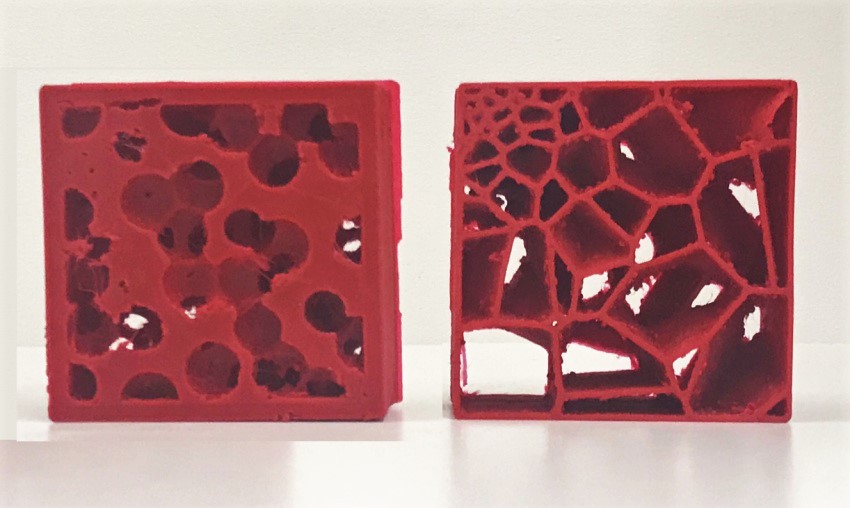 Fig.3: 3D-printed Voronoi applications
Fig.3: 3D-printed Voronoi applications
Robotic Production
Professor Angelo Vermeulen on the social and psychological implications of living in space
The following are extracts from a dialogue with professor Angelo Vermeulen from TU Delft, space system researcher and biologist. Prof. Vermeulen shares his experience in leading one of the analogue space missions in Hawaii as crew commander and the impact confinement has on the psychology of the astronauts. The period of this mission was 4 months, but professor Vermeulen has participated in various other isolation experiments with the purpose of understanding human life in space.
"Mission restrictions:
1. Limited space and reduced privacy (living in a dome with diameter of 11 meters). Everything is there: lab, kitchen, workspace, exercise space, small private rooms.
2. Isolated, no more real time communication with the outside. The only way you can communicate is by emails that are delayed: every email sent is delayed 20 minutes and every reply get delayed by 20 minutes, which is the max delay you would have on real Mars.
3. Proper water supply was limited. We had access to a few very quick showers. I didn’t shower for a full month, instead using wet wipes and disinfecting liquid.
4. No fresh food, only shelf stable food supplies. Resupplies were possible if needed, but it was as if a cargo landed on Mars. A truck would deliver a cargo far away from our habitat, we would get a message, put on our space suits and would pick up the package. That simulated something arriving from Earth.
5. Habitat is a pretty open floor plan – gives the impression that things are spacious. You are in touch with each other, you don’t hide away from each other. You can reorganize the space according to what you need. Sometimes it becomes a workspace, a sports space – the space is flexible.
6. Diverse crew space. Culturally different backgrounds. The diversity made the experience very interesting – engaging conversations, different troubleshooting. If we move forward with space exploration, we need to bring in more women.
7. A bedroom – tiny room with no window, but the little space you have in that room is much appreciated, if you are living like this.
8. Only one porthole window through which to look outside.
9. EVA (Extravehicular activity) – going outside. We had to wear space suits (space suit simulators) – they inhibit your movements and isolate you from the outside air. So basically during all these months of isolation you don’t have any direct contact with fresh air. Most of these missions were set to study local geology and geological history.
We spent our days mostly doing all types of research, but the main study we were doing was a food study.
Space food is much richer nowadays, and astronauts are much happier about it (for instance tortillas are the most favorite food items on the space station because astronauts can customize the tortillas a little). However the problem of menu fatigue is real (it is also experienced by soldiers in the military – by eating the same food over and over again, you start eating less), and you don’t want skinny astronauts undernourished to arrive to Mars. We tried to come out with a solution. Challenges: food needs to be preserved in an easy way (no fridges), as light as possible, contain a lot of calories and be healthy and diverse. We were the crew allowed to prepare our own meals starting from ingredients (shelf-stable): 2 days of astronaut foods. The idea is that if you allow astronauts to cook their own food that would eliminate menu fatigue.
Other psychological and social aspects of HI-SEAS
1. Phenomena experienced: the fact of confinement starts to wave you down. In the second half of the mission, I started thinking that when I will be out of there I would be happy to just be in a room and able to open the door at any given moment.
2. The sense of warping of time, difficult to describe. We normally have a rich source of input from morning to evening, but on space missions we miss all the clues we have in daily life. Everything that happens is similar to other events and limited. That causes that our memory about what happened last week or two weeks ago to blur out. Time is running at a different speed.
3. Sleep quality goes down. Any time astronauts are in isolation, they develop sleep issues.
4. I was a commander. It was crucial to keep the crew together.
5. The biggest challenge, quite unexpected, was keeping communication with mission control in order. They were discussions, fights with mission control, from the beginning of ISS. On Mars astronauts’ reaction to the requirements of Mission Control could be: “why are you telling this, you’re not here, you don’t know”. This happens very easily. When you live in isolation you put everything under the microscope. So you read this email and maybe the person who wrote it was just being very quick and you analyze every sentence and think: oh, that’s quite a nasty way to put it. The whole crew gets a bit armed, and the person says: oh, I didn’t intend it this way."
As professor Vermeulen concluded, "going to Mars will probably be less a situation of lab performing experiments but more of a human experience."
Experiments with ice caps as insulation medium from radiation
Keywords
Inflatable, ice cap, pressurization, radiation shield.
Abstract
The discovery of water ice immediately under the surface of Mars by NASA’s Phoenix lander in 2008 prompted in our team an idea. Due to the very thin atmosphere surrounding the planet, an inhabited space needs good shielding from radiation. Solid water presents an opportunity.
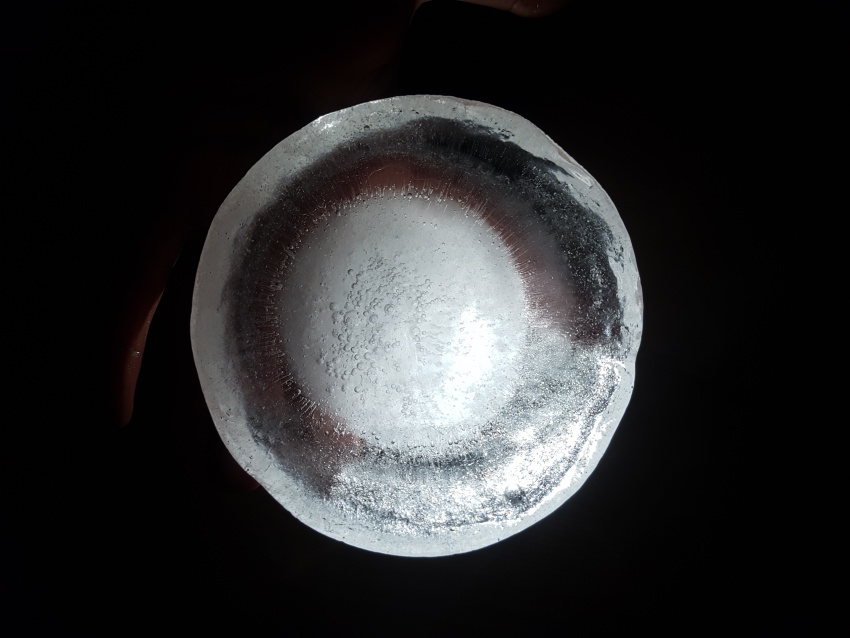 Fig.4: Experiment for an ice cap
Fig.4: Experiment for an ice cap
Description
We have considered two options, both based on the act of excavating the soil. The first kind of excavation needs to go deep enough so that a thickness of 5 meters of Martian soil can act as insulation for the radiation. The second one, for the moment in its conceptual and experimental stage, still underground, would minimize the excavation effort and insulation from radiation will rely on an ice cap of 1 meter thickness. Because water does not subsist in liquid form in the atmospheric conditions aforementioned, the ice caps will be enclosed and pressurized to prevent loss of ice mass (for example during the day when temperatures rise to 20 degrees Celsius.
For the time being, the team considers also the capabilities of these ice caps to absorb and transmit (sun)light, functioning as skylights. Several geometries will be explored and made available to ‘take a shine to’.
First experiment, Inspired by diverging-lens geometry. The convex side as seen from top-view, collects light and transmits it. It was visible, through the experiments, that the point where this curved surface is cut by an arbitrary plane, the ‘cut’ edges will shine the light transmitted from the opposite side.
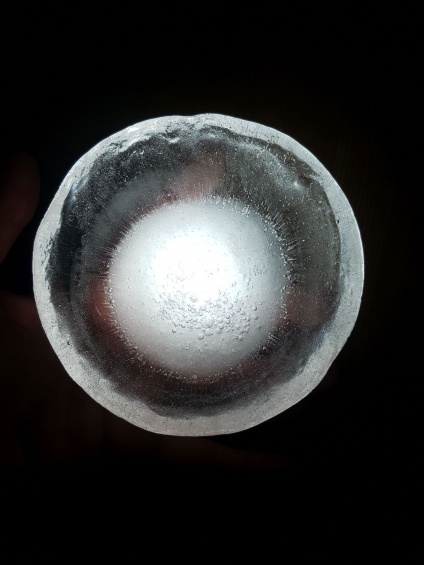
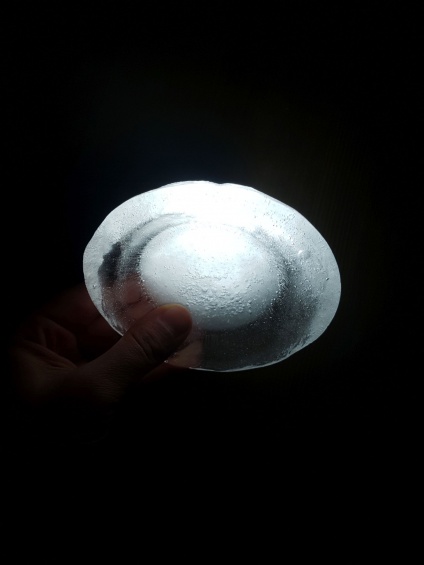
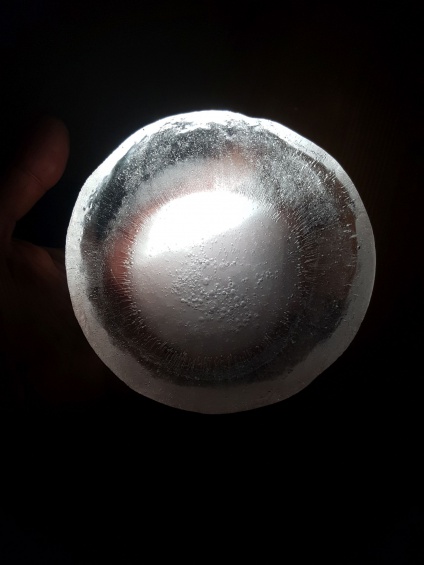
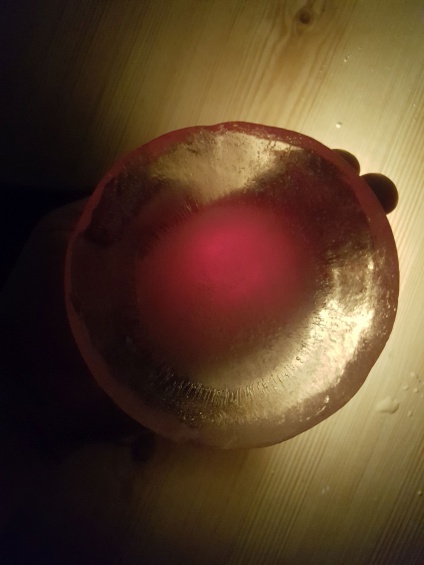 Fig.5: study of transmission of light in different illumination conditions
Fig.5: study of transmission of light in different illumination conditions
Future questions
Further research will explore the feasibility of this idea in terms of:
1. Capabilities of pressurization of this specific inflatable.
2. Availability of ice to be used.
3. Technology necessary to model the ice in the desired shape.
4. Structural challenges.
Stay tuned for more!
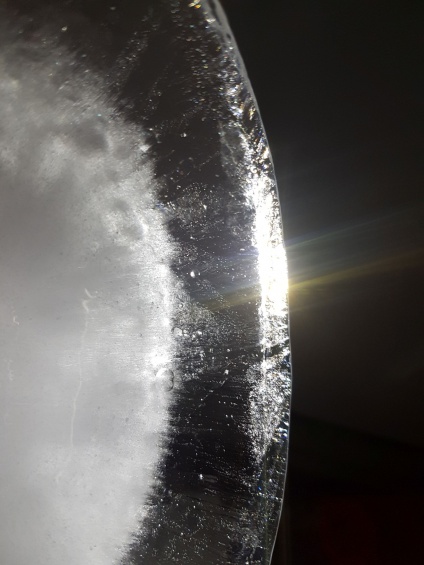
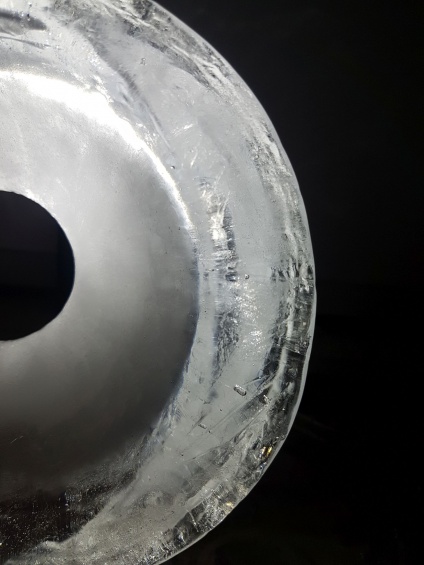 Fig.6: Conditions of light transmission within fragmented mediums (top) and at sharp angles (bottom)
Fig.6: Conditions of light transmission within fragmented mediums (top) and at sharp angles (bottom)
References:
1.Robotic Landscapes: Designing Formation Processes for Large Scale Autonomous Earth Moving PDF Link
2.Autonomous Additive Construction on Mars PDF Link
3.Automation in Construction-Large-scale 3D printing by a team of mobile robots PDF Link
4.Power related solutions for the proposal RTG:PDF Link
5.Design and Development of the ESA Am-Fueled Radioisotope Power Systems PDF Link
6.European Space Nuclear Power Programme: UK Activities PDF Link
7.ESA HHM Report:PDF Link
8.NUCLEAR POWER TECHNOLOGIES FOR DEEP SPACE AND PLANETARY MISSIONS: PDF Link
9.Power solutions for cold dark environments: PDF Link
10.Powering a colony on mars:PDF Link
11.Turning Heat into electricity: PDF Link
